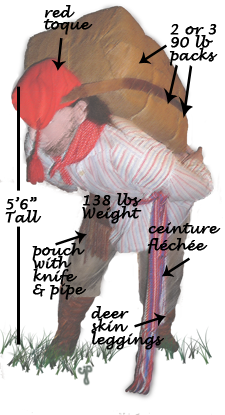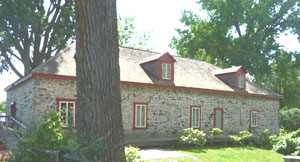Le Voyageur.
Voyageurs were to the fur industry what truckers were to 20th century retail stores, hauling goods over great distances. After the conquest in 1760 most of the investors were British (often the Scots). But they needed the French who had long-standing relations with the native population for it was they who did the bulk of the trapping. Much of the trading took place over the Great Lakes far to the west of Montréal.

video of French Canadian music
Young unmarried men around the age of 22 were recruited. The 8 or 10 men were expected to paddle 40-60 strokes a minute to propel the large but lightweight birchwood canoes they used to travel the 3100 miles from Lachine to Grand Portage on Lake Superior. They kept time with rousing choruses of French folk songs. The avant who acted as guides in the front of the boat received almost twice as much pay as the milieu paddling. Likewise the gouvernail who steered in the rear was better paid.
The large canoes held about 3½ tons of goods to trade for the pelts so desired in Europe. At times travel on the rivers was blocked by falls or perhaps a widely circuitous route. In these cases the men were to expected to portage, or carry the load and their canoes across the land connecting two waterways. Grand Portage on Lake Superior was an eight and a half mile stretch that was so well used that the trail was soon worn down to the granite rock underneath the soil.
The North West Company and Pierre Petel.
Two Scottish brothers, Benjamin and Joseph Frobisher, were agents of the North-West Company headquartered in Montréal. Benjamin, in a "memorial", declared he had arranged for 28 canoes in April, expecting to reap a value at around £25,000 for each boat (A rather ambitious price based on earlier expeditions.)
On 7 May 1784 Pierre Petel, 36, signed a contract with Benjamin Frobisher to go to Grand Portage. At 100-200 livres Pierre's wages would be about double what he would earn in LaPrairie. At that age, it is unlikely this was the first or only time he made the trip.

The crew began their journey with a Mass at Sainte-Anne-de-Bellevue. For the next six to eight weeks they would rise before the sun and paddle 14 hours a day. After a few hours they stopped for a meal on the shore. Lunch was often hard tack that was consumed between dipping the paddle. They could pause briefly each hour to smoke their pipes, but for the most part they were expected to keep up the endless rhythm until nightfall.
The Frobishers' canoes were laden with ⅔ goods for trade and ⅓ provisions. This did not provide enough food for the journey so boats were sent out ahead of the voyageurs to drop supplies. They also may trade along the way, but this was meant to be a quick journey and did not allow for hunting or fishing. Dinner was served from a large pot of peas, salt pork and water that simmered the night before. The canoes were brought onshore and unloaded to serve as shelter as the men slept on the ground underneath. It could be brutally hot, and black flies were discouraged by covering themselves in bear grease.
Grand Portage.
The men coming from Montréal were somewhat derisively called mangeur de lard by the hivernants who wintered in area. The canoemen, according to Frobisher, would transport the goods to the trading post where the deals were cut. This process could take about 15 days. Once negotiations were completed the men loaded the boats with the furs for the trip home.
Back in LaPrairie
Pierre's life ended at the age 62 in LaPrairie on 24 March 1810. At that time he was described as a laborer. His wife Josephte Bulteau, who had stood as godmother for several of their grandchildren, passed on 3 December 1839 and was buried three days later in LaPrairie.
- 54 Victoria. Sessional Papers (No. 6A.) A. 1891, pages xxvi, 51
- Rapport de l'archiviste de la province de Quebec ...); Imprimeur de sa Majesté le Roi, 1946-1947, Repertoire des engagements pour l'ouest, p 337 "Engagement de Pierre Petelle au Sr Benjamin Frobisher pour aller au Grand Portage. -Etude Frs Leguay, pere"
- https://thecanadianencyclopedia.com/en/article/north-west-company/ 4/5/14 accessed; Fur Trade article by John E. Foster, W.J. Eccles; revised by Richard Foot; published 07/23/13 ; last edited 04/02/14
